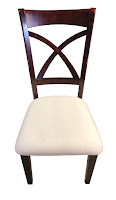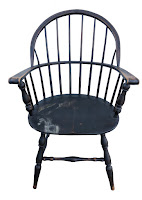Here's another old beauty of a rocking chair that need the broken caned seat replaced. Like many older chairs with caned seats, they tend to get broken after years of use because the cane gets brittle and if a child happens to put their knee onto it, well, there goes the caning with a hole in the middle. If the caning is slightly bent in the middle, it can be made taut again by placing a damp towel on the seat overnight. This technique softens the cane, thus tightening gradually when it dries and giving it more use, at least for a little while. But when it completely breaks through, the only alternative is removing the old,
 |
Antique Rocking
Chair After |
broken cane and replacing it with new cane. This is a “strand” cane chair, which means that it has holes surrounding the chairs seat where the cane strands get woven through. This is a seven-step process that is quite tedious, but if you listen to music or a podcast (like I do), it’s not so bad. It’s actually pretty relaxing once you get into the groove of it and allow your fingers to work their magic.
For this chair, I used 2.25mm fine caning. This is based on the size caning that was in the chair originally. There are methods to measure the distance between the center to center holes to determine the proper size caning to use, but I prefer just to measure the existing old cane to make sure it will fit since the hole technique isn’t always accurate. The reason is that when many of these very old chair were made, whoever drilled the holes didn’t always measure the exact distance between holes as well as the size of the holes, therefore to use just the holes is not the more accurate way to get the proper new caning installed.
In my experience, it’s better to use a slightly narrower size than one that is too large as this will be a real problem during the final binding step. If the cane is too big and overfills the holes, it’s nearly impossible to get the final strands through the holes without pushing the cane back out of the holes you’ve worked so hard to get securely in place.
This was to date my very best caning job because everything flowed smoothly and the caning was even and straight. The trickiest part was the the curved arm was attached very closely to the holes on that part of the seat, so the arms had to be lifted up enough so that I could thread the caning through the 6 or 7 holes that were very close to the bottom of the armrest. Some of those holes were drilled at an angle, so that made caning in those areas even more challenging as I tried to find the angle of the hole. However, once that was completed, the rest was easy by comparison. Caning is always done with the first step going front to back, underneath, then pulled through the hole and brought forward again. You repeat this process from the center all the way to the right (or left) side then finish off the other remaining side in the same manner. The next step is horizontal, left to right, starting in the back upper corner of the chair, following the same weaving.
Third step is going over the first step, keeping the strands to the right of the first vertical strands. This is so that when you weave the fourth step, you go over step 3 and under step 1. This is the actual “weaving” part of caning which will set up the diagonal weaves that go from the upper right to the lower left corners. Finally, you weave from the upper left to the lower right corners, going under vertical and over horizontal one way then the opposite for the other side.
Binding is what finishes off the top. A slightly wider section of caning is measured around the circumference of the chair. This covers up the holes with sections of caning coming up and going down the same hole, pulling tightly to keep the top edge secure. After this is done, you tap in a 1/2” finishing piece to plug the hole(s) where the caning started. It sounds a lot more complicated then it is, but if you follow the steps, you too can become a caning master. It’s definitely a great skill to have, some call a “dying” art as not many people are doing this anymore. It’s also a unique and creative way to add texture to your home with caned pieces such as speaker covers, cabinets and footstools in addition to chair seats and backs.
Here’s the video of the final step of me caning this rocking chair:
https://draft.blogger.com/blog/post/edit/5936537173467203420/6863734281706129925


































